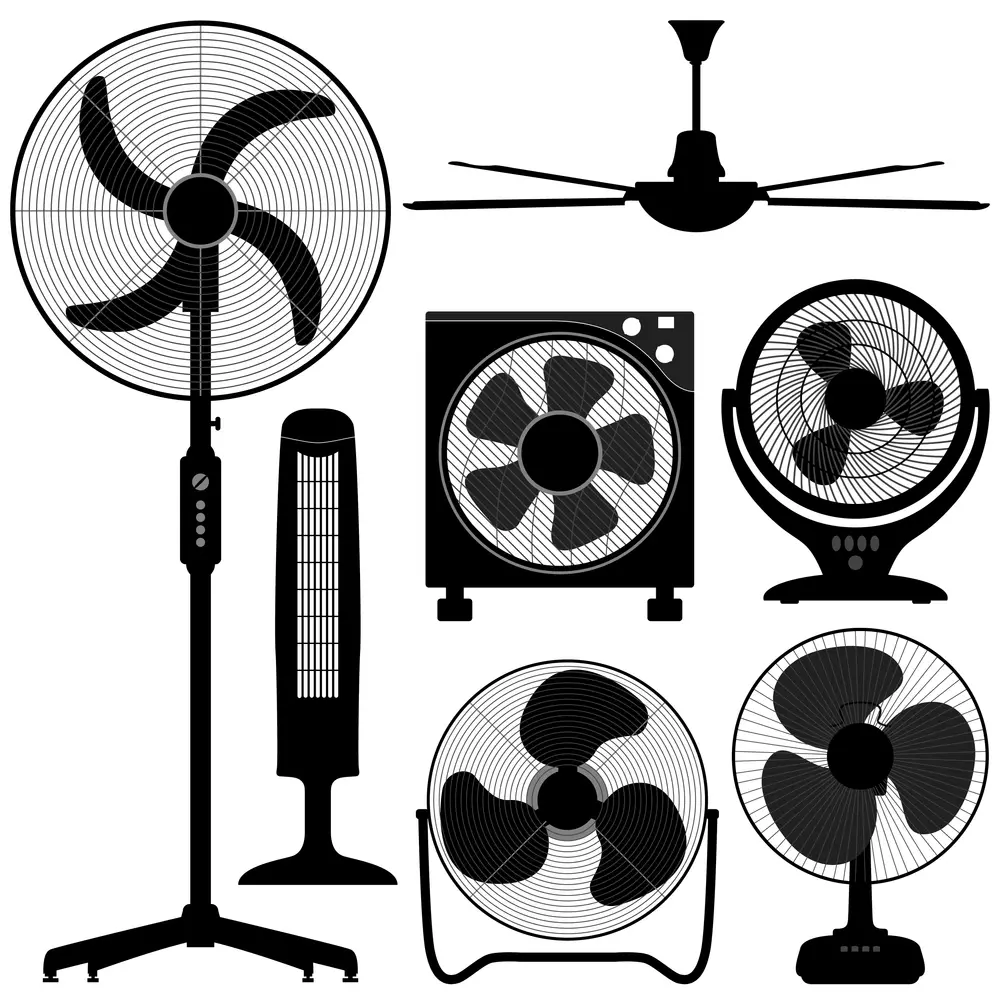When it comes to cooling off during the hot summer months, fans are a popular choice.
But with so many options available, it can be tough to decide which type of fan to use. Is a ceiling fan better than a standing fan?
The answer depends on your specific needs and preferences. Let’s take a closer look at the pros and cons of each option to help you make an informed decision.
Key Takeaways
- Ceiling fans are more efficient and powerful, but they are also more expensive and require installation.
- Standing fans are portable and less expensive, but they are also less powerful and efficient.
- Choosing the right fan for your needs depends on factors such as room size, budget, and portability requirements.
Understanding Ceiling and Standing Fans
Ceiling fans and standing fans are two of the most popular types of fans used in homes and offices. While both types of fans serve the same purpose, they have different features and benefits that you should consider before making a purchase decision.
Ceiling Fans

Ceiling fans are fixed to the ceiling and are designed to circulate air throughout the room.
They come in a variety of sizes, styles, and designs, and can be used in any room of the house.
Ceiling fans are a great option if you want to improve the airflow in your room and create a comfortable environment.
One of the main advantages of ceiling fans is that they are more energy-efficient than standing fans.
They use less energy to operate and can help you save money on your electricity bill.
Additionally, ceiling fans are more effective in cooling a room than standing fans, as they can move more air and create a more consistent breeze.
Ceiling fans also come with a variety of features, such as remote control operation, adjustable speed settings, and built-in lighting.
Some ceiling fans even have smart technology that allows you to control them with your smartphone or voice commands.
Standing Fans
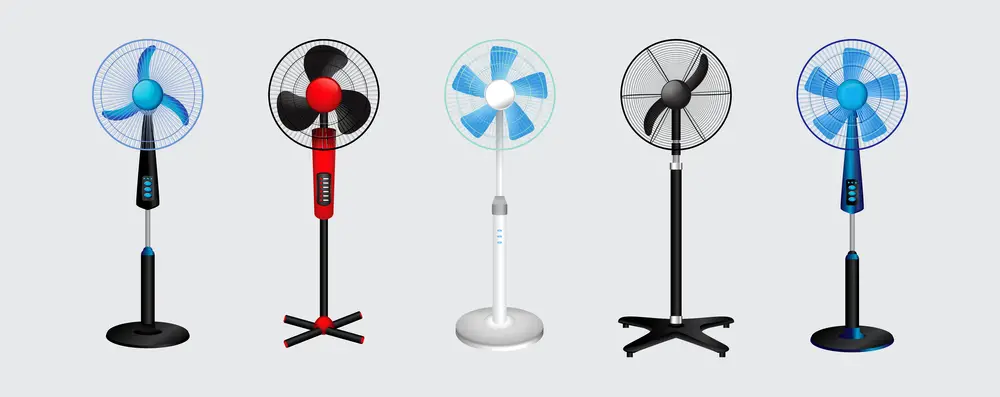
Standing fans, also known as pedestal fans, are portable and can be moved from room to room. They are designed to provide a direct breeze to a specific area and are ideal for use in small rooms or areas where a ceiling fan is not practical.
One of the main advantages of standing fans is that they are easy to assemble and require no installation.
They can be set up in minutes and are ready to use right out of the box. Additionally, standing fans are more affordable than ceiling fans and can be a great option if you are on a budget.
Standing fans come with a variety of features, such as adjustable height, oscillation, and multiple speed settings.
Some standing fans even come with built-in air purifiers or ionizers, which can help improve the air quality in your room.
| Ceiling Fans | Standing Fans |
|---|---|
| Fixed to ceiling | Portable |
| More energy-efficient | More affordable |
| More effective in cooling a room | Direct breeze to specific area |
| Remote control operation, adjustable speed settings, built-in lighting | Adjustable height, oscillation, multiple speed settings |
| Smart technology available | Built-in air purifiers or ionizers available |
Ceiling vs Standing Fans Features Comparison
When it comes to choosing between a ceiling fan and a standing fan, it’s important to consider the features of each. In this section, we’ll compare the features of both types of fans to help you make an informed decision.
Ceiling Fan Features
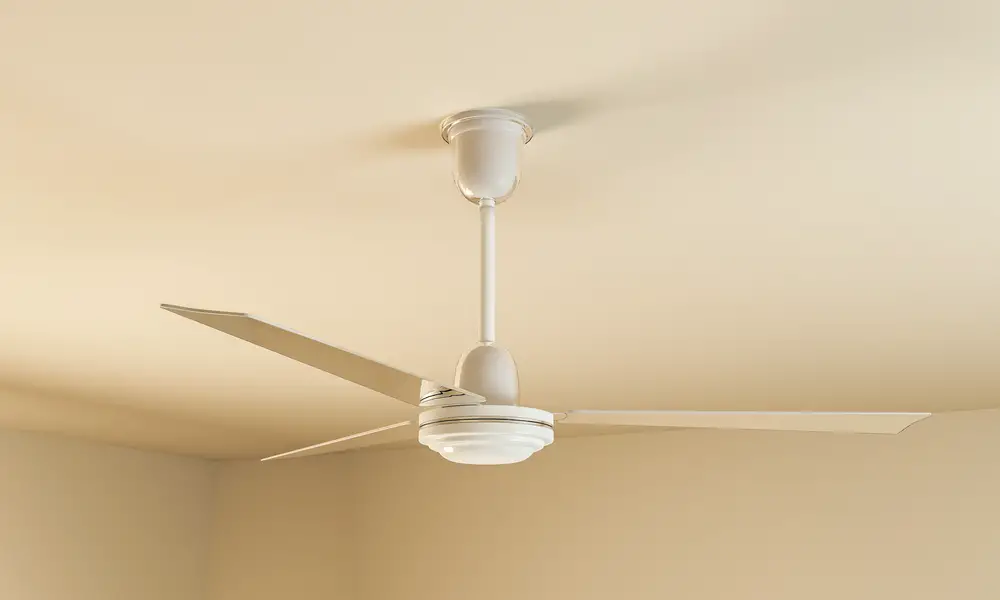
Ceiling fans are a popular choice for many homeowners due to their ability to circulate air and provide a comfortable environment. Here are some of the key features of ceiling fans:
- Design: Ceiling fans come in a variety of designs, from traditional to modern. You can choose a fan that matches your home decor and personal style.
- Number of blades: Ceiling fans typically have three to five blades, which help to circulate air effectively. However, some fans may have more or fewer blades.
- Blade span: The blade span of a ceiling fan can range from 29 inches to over 60 inches. A larger blade span can provide more air circulation, but it may not be suitable for smaller rooms.
- Light fixtures: Many ceiling fans come with built-in light fixtures, which can provide additional lighting in a room. You can choose from a variety of light fixture designs to match your decor.
- Modern design: If you’re looking for a modern ceiling fan, you can choose from a range of sleek and stylish designs. These fans often feature unique blade shapes and finishes.
Standing Fan Features
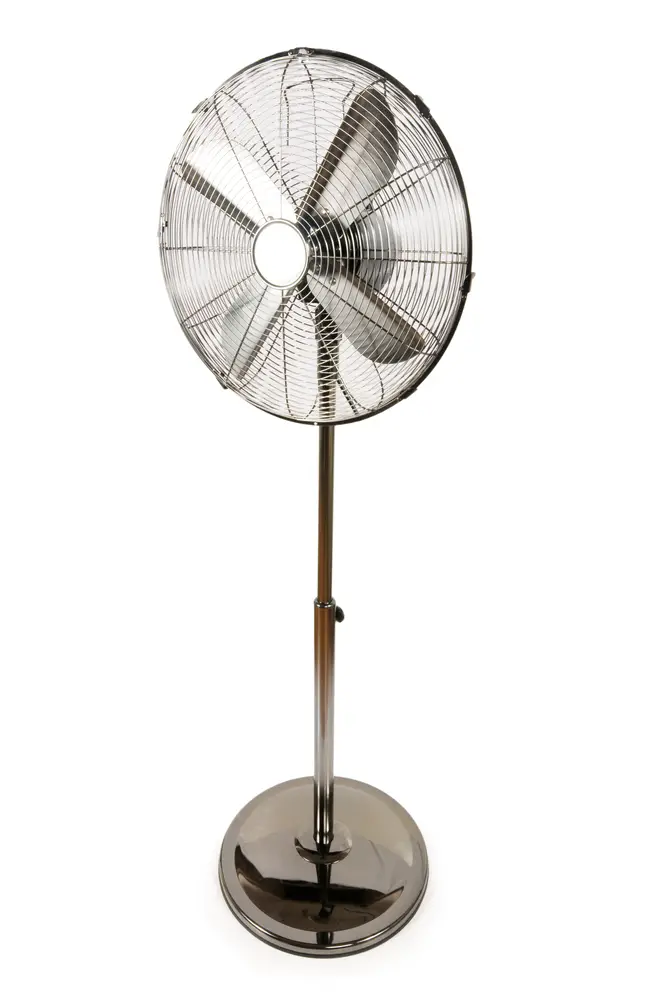
Here are some of the key features of standing fans:
- Design: Standing fans typically have a simple and functional design. They are available in a range of colors and finishes to match your decor.
- Number of blades: Standing fans usually have three blades, which help to circulate air effectively.
- Blade span: The blade span of a standing fan is typically smaller than that of a ceiling fan, ranging from 12 inches to 18 inches.
- Light fixtures: Standing fans do not come with built-in light fixtures.
- Modern design: Standing fans are available in a range of modern designs, with features such as remote controls and adjustable heights.
Ceiling vs Standing Fans Efficiency and Power
Efficiency of Ceiling Fans
Ceiling fans are more energy-efficient than standing fans.
According to Eco Cost Savings, the average ceiling fan wattage is 31.1W, and it costs $0.004 per hour to run a large ceiling fan, on average, in the US. Ceiling fans have an average CFM/W of 287.8, which is better than standing, box, and tower fans. They move the most air per watt, making them the most efficient fan type.
Ceiling fans are designed to circulate air and provide an even distribution of cool or warm air throughout the room.
They create a gentle, constant breeze that cools you down in summer and also helps distribute warm air during winter months.
This means that you can use your air conditioning or heating system less often, saving you money on your energy bills.
Power of Standing Fans
Standing fans are less efficient than ceiling fans, but they are still a popular choice for many people.
According to Eco Cost Savings, fans use 0.0393 kWh of electricity per hour on average (all fan types combined), and in the US, on average, it costs $0.0059 per hour to run a fan.
Box fans are the most efficient fan type for personal cooling, but they are not as effective at cooling large rooms as ceiling fans.
Standing fans are portable and easy to move around, making them a great choice for people who need to cool different areas of their home at different times of the day.
They are also less expensive than ceiling fans, making them a more accessible option for people on a budget.
| Fan Type | Average Power Consumption (Watts) | Average Cost per Hour (USD) |
|---|---|---|
| Ceiling | 31.1 | 0.004 |
| Standing | N/A | 0.0059 |
Ceiling vs Standing Fans Cooling and Air Circulation
When it comes to cooling and air circulation, both ceiling fans and standing fans have their own advantages. Let’s take a closer look at each.
Cooling Capacity of Ceiling Fans
Ceiling fans are designed to cool large spaces. They have longer blades than standing fans, which means they can move more air. This makes them ideal for use in living rooms, bedrooms, and other large spaces.
Ceiling fans also have the ability to concentrate cool air in a specific area. This is because the blades are angled downwards, which creates a downward flow of air. This can be especially useful on hot summer days when you want to cool down quickly.
Air Circulation of Standing Fans
Standing fans are designed to circulate air throughout a room. They are typically smaller than ceiling fans, which makes them more portable. This means you can move them from room to room as needed.
Standing fans are also great for creating a breeze. This is because they can be angled in any direction, which allows you to direct the flow of air wherever you need it most. This can be especially useful if you want to create a cool breeze while you’re working or relaxing.
Ceiling vs Standing Fans Installation and Maintenance
Installing Ceiling Fans
Installing a ceiling fan can be a bit tricky, but it is not impossible. You can hire a professional electrician to do the installation for you, or you can do it yourself if you have some electrical knowledge. The installation process involves mounting the fan bracket to the ceiling, wiring the fan, and attaching the fan blades.
The cost of installing a ceiling fan varies depending on the complexity of the installation and the location.
On average, you can expect to pay between $75 to $200 for installation. However, if you are installing a smart ceiling fan, the installation cost can go up to $500 or more.
Here are some tips to maintain your ceiling fan:
- Dust the fan blades regularly to prevent the accumulation of dust and dirt.
- Tighten the screws and bolts periodically to prevent any wobbling or noise.
- Lubricate the motor bearings annually to keep the fan running smoothly.
Maintaining Standing Fans
Maintaining a standing fan is relatively easy. You can clean the blades and the grill with a damp cloth or a soft brush. You can also disassemble the fan and wash the blades and grill with soap and water.
To maintain the standing fan’s motor, you can lubricate it with a few drops of oil. The frequency of lubrication depends on how often you use the fan. If you use the fan regularly, you should lubricate the motor once every six months.
The cost of maintaining a standing fan is minimal. You only need to replace the blades or the grill if they are damaged or broken. The cost of replacement parts varies depending on the brand and model of the fan.
Ceiling vs Standing Fans Cost and Budget Considerations
When it comes to choosing between a ceiling fan and a standing fan, cost and budget considerations are crucial. In this section, we’ll take a closer look at the cost of ceiling fans and budgeting for standing fans.
Cost of Ceiling Fans
Ceiling fans tend to be more expensive than standing fans. The cost of a ceiling fan can vary depending on the brand, size, and features. On average, a good quality ceiling fan can cost anywhere from $100 to $500. However, some high-end ceiling fans can cost upwards of $1,000.
It’s important to keep in mind that the cost of a ceiling fan doesn’t just include the price of the fan itself. You’ll also need to factor in the cost of installation, which can range from $50 to $200 depending on the complexity of the installation.
Budgeting for Standing Fans
Standing fans are generally more budget-friendly than ceiling fans. The cost of a standing fan can vary depending on the brand, size, and features. On average, a good quality standing fan can cost anywhere from $20 to $100.
One of the advantages of standing fans is that they don’t require any installation costs. You can simply plug them in and start using them right away. However, it’s important to keep in mind that standing fans can be less durable than ceiling fans and may need to be replaced more frequently.
When budgeting for a standing fan, it’s important to consider the size of the room you’ll be using it in. A larger room may require a larger fan, which will be more expensive. Additionally, if you’re looking for a standing fan with advanced features such as remote control or oscillation, you can expect to pay a higher price.
Ceiling vs Standing Fans Portability and Space Usage
When it comes to choosing between a ceiling fan and a standing fan, portability and space usage are important factors to consider. Let’s take a closer look at these factors and how they differ between the two types of fans.
Portability of Standing Fans

One of the main advantages of a standing fan is its portability. Standing fans are designed to be moved from room to room, making them ideal for those who want to keep cool in different areas of their home.
They are also lightweight and easy to carry, which means you can take them with you when you travel or move to a new location.
Standing fans come in different sizes, so you can choose one that fits your needs. If you have a small room, a compact standing fan might be the best option. If you have a larger room, a bigger standing fan can provide more airflow and cooling power.
Space Usage of Ceiling Fans

Ceiling fans are fixed to the ceiling and cannot be moved around like standing fans. However, they are a great option for those who want to save space in their home. Ceiling fans take up zero floor space, which means you can use the space for other things.
Ceiling fans are also ideal for rooms with low ceilings. Since they are mounted on the ceiling, they do not take up any vertical space. This makes them a great option for rooms with low ceilings where a standing fan might not fit.
| Fan Type | Portability | Space Usage |
|---|---|---|
| Standing Fan | Portable, can be moved from room to room | Takes up floor space |
| Ceiling Fan | Fixed to the ceiling, cannot be moved | Takes up zero floor space |
Ceiling vs Standing Fans Safety and Noise Levels
Safety of Ceiling Fans
Ceiling fans are generally considered safe as long as they are installed and used properly. However, it is important to keep in mind that ceiling fans can be dangerous if they are not installed correctly or if they are used improperly.
For example, if a ceiling fan is not securely mounted to the ceiling or if it is installed in a location where it can come into contact with people or objects, it can cause serious injury or damage.
To ensure the safety of your ceiling fan, it is important to have it installed by a professional electrician.
They will ensure that the fan is securely mounted to the ceiling and that it is installed in a safe location. It is also important to keep children and pets away from the fan when it is in operation to prevent any accidents.
Noise Levels of Standing Fans
Standing fans can be a great option for cooling a room, but they can also be noisy. The noise level of a standing fan can depend on a number of factors, including the size of the fan, the speed at which it is running, and the quality of the fan’s motor.
If noise is a concern for you, it is important to choose a standing fan that is designed to operate quietly. Look for fans that have a noise rating of 50 decibels (dB) or less. You can also consider using a larger fan at a lower speed, as this can help to reduce the amount of noise that the fan produces.
When it comes to safety, standing fans can also pose a risk to children and pets. The blades of a standing fan can be dangerous if they come into contact with fingers, paws, or tails. To prevent any accidents, it is important to keep children and pets away from the fan when it is in operation.
Ceiling vs Standing Fans Environmental Impact
Environmental Impact of Ceiling Fans
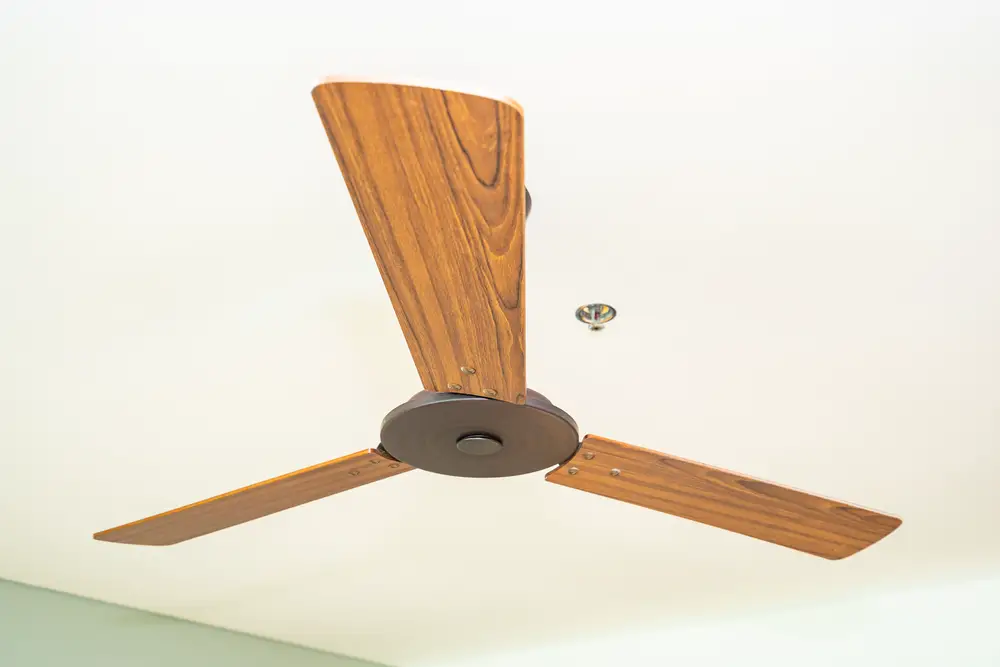
Ceiling fans are generally considered to be more environmentally friendly than standing fans. They are designed to circulate air and provide an even distribution of cool or warm air throughout the room.
This means that they create a gentle, constant breeze that cools you down in summer and also helps distribute warm air during winter months.
Ceiling fans are also more energy-efficient than standing fans.
According to IAFC, ceiling fans have been shown to reduce energy usage by as much as 40% in the summer and 10% in the winter. They do this by creating air movement that expands the acceptable comfort range of the space.
Ceiling fans are also available with an Energy Star rating, which means that they meet strict energy efficiency guidelines set by the US Environmental Protection Agency.
Energy Star rated ceiling fans are up to 60% more efficient than conventional fan/light units, which can help you save money on your energy bills and reduce your carbon footprint.
Environmental Impact of Standing Fans
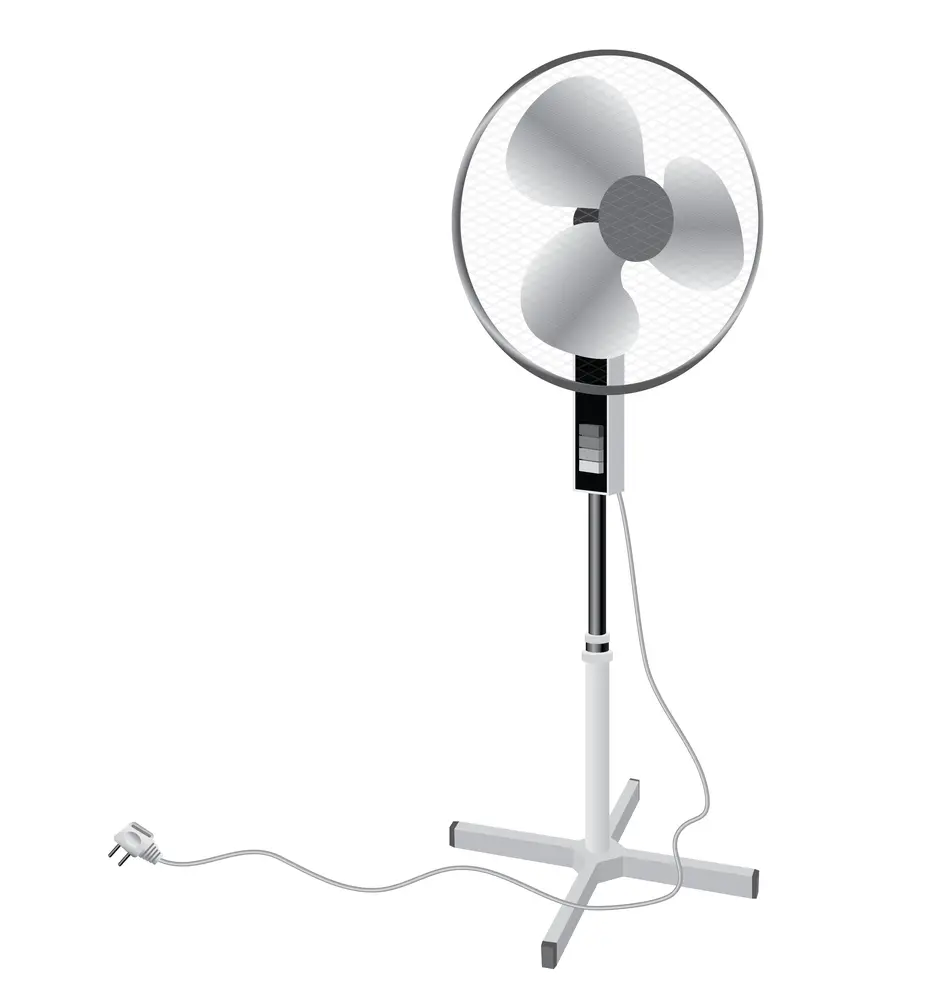
Standing fans are generally less energy-efficient than ceiling fans. They are designed to provide a direct flow of air to a specific area, rather than circulating air throughout the entire room. This means that they often have to be turned up to a higher speed to achieve the same level of cooling as a ceiling fan.
Standing fans are also often made from plastic and metal, which are non-renewable materials sourced via mining, which is also a source of pollution and environmental destruction.
According to Citizen Sustainable, this manufacturing process contributes to greenhouse gas emissions and environmental degradation.
However, standing fans are often more affordable than ceiling fans and can be moved from room to room as needed, which can be an advantage for those who do not want to invest in a ceiling fan for every room.
| Fan Type | Energy Efficiency | Environmental Impact |
|---|---|---|
| Ceiling Fans | Up to 60% more efficient than conventional fan/light units | Made from non-renewable materials, but can be Energy Star rated |
| Standing Fans | Less energy-efficient than ceiling fans | Made from non-renewable materials, which contribute to greenhouse gas emissions and environmental degradation |
Ceiling vs Standing Fans Brand and Aesthetics
When it comes to choosing between a ceiling fan and a standing fan, brand and aesthetics can play a significant role in your decision-making process.
Firstly, let’s talk about brands. There are many brands out there that offer both ceiling fans and standing fans, and it can be overwhelming to choose one.
However, some of the most well-known brands in the market are Hunter, Emerson, Minka-Aire and Casablanca. These brands have been around for a long time and have a reputation for producing high-quality fans.
If you’re looking for a fan that not only functions well but also looks great, then aesthetics is an essential factor to consider. Ceiling fans come in a variety of designs, from traditional to modern, and can add an extra touch of elegance to your room.
Some of the most popular ceiling fan designs include the classic five-blade design, the industrial look, and the sleek and modern design. On the other hand, standing fans come in different sizes and shapes, but they all have a similar look.
If you’re looking for a fan that can complement your room’s décor, then you should choose a ceiling fan that matches your room’s style. For example, if you have a traditional room, you can choose a ceiling fan with a wooden finish and a classic design. If you have a modern room, you can choose a ceiling fan with a sleek and minimalistic design.
To help you choose the right fan for your room, we’ve compiled a table that compares the aesthetics of ceiling fans and standing fans:
| Ceiling Fans | Standing Fans |
|---|---|
| Comes in a variety of designs | Limited designs |
| Can add an extra touch of elegance to your room | Have a similar look |
| Can complement your room’s decor | Limited options for matching your room’s style |
In conclusion, when it comes to choosing between a ceiling fan and a standing fan, brand and aesthetics are essential factors to consider. You should choose a fan from a reputable brand and select a design that complements your room’s decor.
Ceiling vs Standing Fans Pros and Cons
Pros and Cons of Ceiling Fans
Ceiling fans are a popular choice for many homeowners because of their ability to circulate air and provide an even distribution of cool or warm air throughout the room. Here are some pros and cons of ceiling fans:
Pros
- Improved airflow: Ceiling fans are designed to circulate air and provide an even distribution of cool or warm air throughout the room. They create a gentle, constant breeze that cools you down in summer and also helps distribute warm air during winter months.
- Energy-efficient: Ceiling fans can be an energy-efficient alternative to air conditioning, especially when used in conjunction with your AC unit. By circulating air, ceiling fans help to reduce the load on your AC unit, which can help to lower your energy bills.
- More advanced features: Ceiling fans come with a wide range of features, including smart technology, remote controls, and more. Some models even come with built-in lights, making them a great choice for rooms with limited space.
Cons
- Installation costs: Ceiling fans can be expensive to install. You may need to hire a professional electrician to install your ceiling fan, which can add to the overall cost.
- Noise: Some ceiling fans can be noisy, especially at high speeds. This can be a problem if you’re trying to sleep or work in a quiet environment.
Pros and Cons of Standing Fans
Standing fans, also known as pedestal fans, are a popular alternative to ceiling fans. They are portable and can be moved from room to room, making them a great choice for those who need a fan that can be easily moved around. Here are some pros and cons of standing fans:
Pros
- Portability: Standing fans are portable and can be moved from room to room, making them a great choice for those who need a fan that can be easily moved around.
- Easy to install: Standing fans are easy to install and can be set up in just a few minutes. They don’t require any special tools or equipment, which makes them a great choice for those who want a fan that they can set up quickly.
- Cost-effective: Standing fans are generally less expensive than ceiling fans, making them a great choice for those on a budget.
Cons
- Less airflow: Standing fans are generally less powerful than ceiling fans and may not provide as much airflow.
- Limited features: Standing fans don’t come with as many features as ceiling fans. For example, they don’t typically come with smart technology or built-in lights.
- May take up more space: Standing fans can take up more floor space than ceiling fans, which can be a problem if you have limited space in your room.
Overall, both ceiling fans and standing fans have their pros and cons, and the choice between them will depend on your personal preferences and needs.
Conclusion
When choosing between a ceiling fan and a standing fan, it is important to consider your individual needs and preferences. If you value portability and ease of installation, a standing fan may be the better option. If you are looking for more advanced features and greater airflow, a ceiling fan may be the way to go.
Ultimately, the choice between a ceiling fan and a standing fan is a personal one that depends on your specific needs and preferences. By considering the pros and cons of each type of fan and weighing them against your own needs, you can make an informed decision and choose the fan that is right for you.

